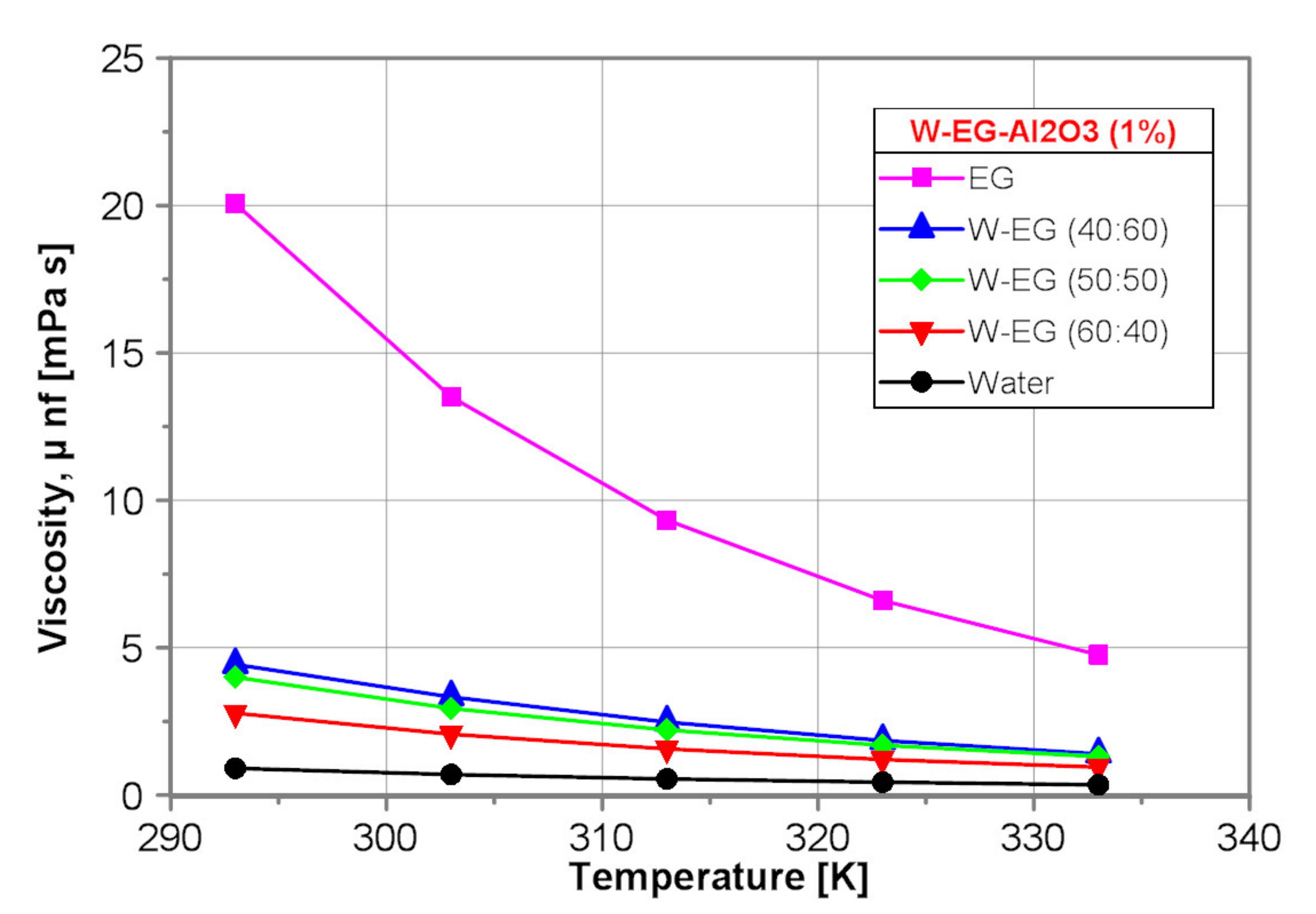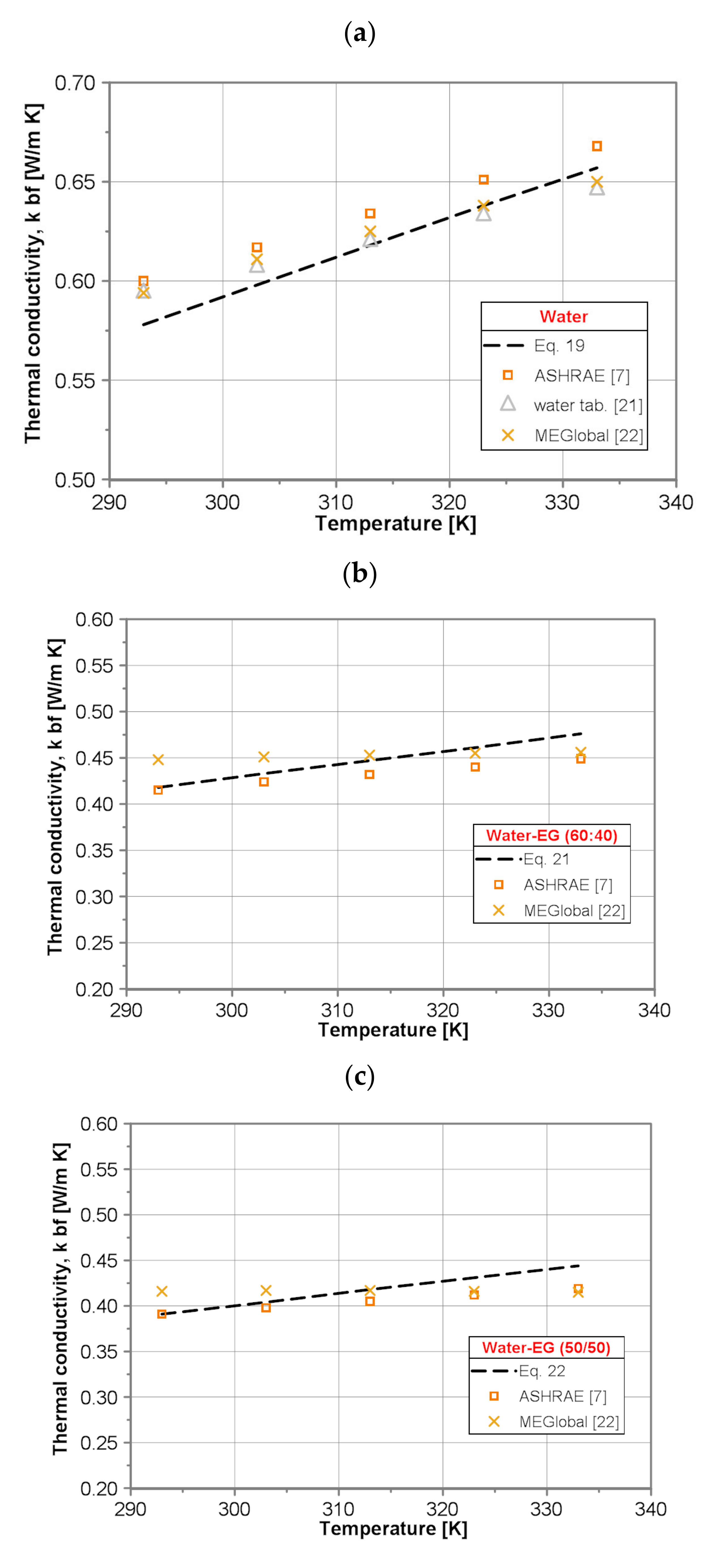In the present study, the thermal conductivity of the tested liquids was measured by use of KD2 Thermal Properties Analyser of the Decagon Devices Inc. (Pullman, WA, USA). With the implemented sensor the measurement was possible for the thermal conductivity range from 0.02 to 2.00 W/(mK) and the temperature range from −20
to 60 °C. In this work, the thermal conductivity was determined for the temperature range of +20 to +40 °C. Maximum expected uncertainty amounts: ±5%. For the measurement amount of 20 mL of the prepared nanofluid was put in the laboratory cell and placed in the bath of given temperature. The sensor was immersed in the middle of the sample without any contact with the cell walls. The measurement time for every temperature amounted 2 min. In order to avoid impact of potential agglomeration the thermal conductivity of fresh prepared nanofluid was measured (according to the work in [
6] many abnormal thermal conductivity data in nanofluids result from unstable nanofluids). The details of the measurement set-up and procedure are described in [
18,
19].
2.2.1. Base Fluids
Thermal conductivity of the pure fluids weakly depends on the temperature [
20]. The correlations used to evaluate the thermal conductivity of the base fluids are developed by assuming that thermal conductivity of the base fluids increases linearly with temperature. Regression analysis, using the least squares method, was applied to correlate experimentally obtained data for five tested base fluids.
The correlations are summarized in
Table 4.
In order to check the credibility of the present results, a comparison of the thermal conductivity of the base fluids calculated by the developed correlations (Equations (19–23)) with the data published in the literature for the temperature range of 293 to 333 K has been conducted (see
Figure 6).
It was found that for pure water the values of thermal conductivity predicted by use of developed Equation (19) display reasonable agreement with the literature data [
7,
21,
22] within the whole temperature range. The maximum discrepancy reads ±3.5% and is comparable with the deviation between literature data (±3.4%), as well as is within maximum expected measurement uncertainty (±5%).
For pure EG the values predicted by use of developed Equation (20) and those presented in the literature [
22] deviate from −16% for lower temperature to +9% for higher temperature.
For all three water/EG mixtures, i.e., (60:40), (50:50) and (40:60), corresponding to Equation (21), Equations (22) and (23) underpredict the thermal conductivity of the water/EG mixtures compared to the published data [
7,
20,
21,
22] for lower temperature and overpredict for higher temperature. The maximum discrepancy occurs for data published in [
22] and it deviates from −7% to +4 for water/EG (60:40) mixture, from −6% to +6% for water/EG (50:50) mixture and from −13% to +3% for water/EG (40:60) mixture. The Vajjha and Das correlation (Equation (24)) is based on the data provided for water/EG (40:60) mixture in [
7], and it is seen in
Figure 3 that there is a difference between calculated values and data taken directly from the tables. Correlation (Equation (24)) gives higher values of ~6% within the whole tested temperature range.
Figure 7 shows a comparison of the thermal conductivity of the tested base fluids obtained by use of the proposed correlation equations presented in
Table 4. As it is seen in
Figure 7, the thermal conductivity of water is, independent of temperature, over 2 times higher than that of EG. The thermal conductivity of all tested base fluids increases with temperature by ~13%. Thermal conductivity of the water–EG mixtures decreases distinctly with water content decrease.
2.2.2. Nanofluids
The present thermal conductivity data of the tested nanofluids were correlated in the form that was originally proposed by Patel et al. [
27]:
A multidimensional regression analysis using the least squares method was applied to establish parameters A–E. The developed correlations are presented in
Table 5.
In order to check the reliability of the present developed correlations, a comparison of the calculated values of the thermal conductivity of the tested nanofluids with the predictions made by correlations published in the literature has been conducted.
The Sundar et al. [
15] correlation for thermal conductivity of EG/water mixtures with dispersed Al
2O
3 nanoparticles is as follows.
For mixture EG/water (40:60 by mass)
For mixture EG/water (60:40 by mass)
The Chiam et al. [
16] correlation for thermal conductivity of water/EG mixtures with ratio (BR) of 40:60, 50:50 and 60:40 by volume with seeded Al
2O
3 nanoparticles is as follows.
Khanafer and Vafai [
4] proposed the following correlation for water/Al
2O
3 nanofluids.
Corcione [
28] developed a correlation for oxide and metal nanoparticles suspended in water or EG-based nanofluids,
where
and k
B = 1.3807 · 10
−23 J/K (Boltzmann constant). Freezing point temperature T
fr of the base fluid was determined based on the work in [
7].
Hassani et al. [
29] proposed a general correlation for various base fluids, metal and oxide nanoparticles in the form
where
is the Brownian velocity.
The assumed properties of alumina (Al
2O
3) nanoparticles are k
p = 35 W/(mK) and ρ
p = 3600 kg/m
3—taken from in [
4,
30], respectively. The boiling point temperature T
B of the base fluid was taken from in [
7]. The d
ref is the molecular diameter of hydrogen, and is equal to 2.9 Å.
Figure 8 shows exemplarily the comparison of the measured values of thermal conductivity of water/ Al
2O
3 nanofluids for nanoparticle concentration of 1% with literature data.
It was found that for the water/Al2O3 (1 wt%) nanofluid the values of thermal conductivity predicted by use of developed Equation (26) display reasonable agreement with the predictions made by use of advanced Corcione correlation (Equation (35)). The maximum deviation ranges from +1.3% for lower temperature to −4.7% for higher temperature. The Hassani et al. correlation (Equation (36)) overpredicts the results obtained by present Equation (26) from +3.7% for lower temperature to +14.8% for higher temperature. Contrary to the Hassani et al. correlation, the Khanafer and Vafai correlation (Equation (34)) underpredicts the results obtained by present Equation (26) by ~5.1% within the whole tested temperature range. The values of thermal conductivity for EG-Al2O3(1 wt%) nanofluid predicted by use of developed Equation (27) are lower by ~3.5% compared to the predictions made by use of the Hassani et al. correlation (Equation (36)) within the whole tested temperature range. The results obtained by the Corcione correlation (Equation (35)) are higher than calculated by present Equation (27), too. The discrepancy increases with temperature increase and amounts 0.8% for lower temperature and 7% for higher temperature. For all three, water-EG/(60:40)Al2O3(1 wt%), water-EG/(50:50)Al2O3(1 wt%) and water-EG/(40:60)Al2O3(1 wt%), nanofluids the literature, correlations overpredict the thermal conductivity within the whole examined temperature range. In the case of the water-EG/(60:40)Al2O3(1 wt%) nanofluid an excellent agreement between Chiam et al. correlation (Equation (33)) and Hassani et al. correlation (Equation (36)) has been found. The maximum difference between these two correlations does not exceed 1.2%. However, both correlations give higher values of thermal conductivity than present Equation (28), and the discrepancy increases from 5.7% for lower temperature to 12.1% for higher temperature. Sundar et al.’s correlation (Equation (31)) gives higher values of thermal conductivity as well, but the discrepancy is almost constant within the whole temperature range and equals ~8%. In the case of the water-EG/(50:50)Al2O3(1 wt%) nanofluid, again good agreement between the Chiam et al. correlation (Equation (33)) and Hassani et al. correlation (Equation (36)) has been found. The maximum difference between those two correlations does not exceed 1.7%. However, both correlations give higher values of thermal conductivity than present Equation (29) and the discrepancy increases from 5.4% for lower temperature to 11.7% for higher temperature.
In the case of water-EG/(40:60)Al2O3(1 wt%) nanofluid, the Chiam et al. correlation (Equation (33)), and Hassani et al. correlation (Equation (36)) give higher values of thermal conductivity than present Equation (30) and the discrepancy increases from 5.2% for lower temperature to 12.1% and 9.3% for higher temperature, respectively. Sundar et al.’s correlation (Equation (32)) gives higher values of thermal conductivity as well, but the discrepancy, in turn, is almost constant within the whole temperature range and equals about 6.2%.
Figure 9 shows a comparison of the thermal conductivity of the tested nanofluids with nanoparticle mass concentration of 1% obtained by use of the proposed correlation equations presented in
Table 5.
Similarly to the base fluids, the thermal conductivity of water-Al2O3 (1%) nanofluid is the highest one. Moreover, the thermal conductivity of all the tested nanofluids increases with water content and temperature increase.
Figure 10, in turn, illustrates exemplarily influence of the nanoparticle concentration on the thermal conductivity of the tested water-Al
2O
3 nanofluids. As shown in
Figure 10, the addition of alumina nanoparticles results in an increase of thermal conductivity of water-Al
2O
3 nanofluids from 1.2% to 3.8% for mass concentration of 0.01% and 1%, respectively.



















